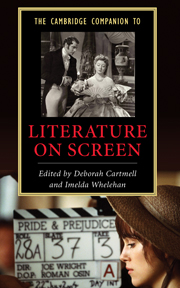Book contents
- Frontmatter
- Introduction - Literature on screen: a synoptic view
- Part One Theories of Literature on Screen
- 1 Reading film and literature
- 2 Literature on screen, a history: in the gap
- Part Two History and Contexts
- Part Three Genre, Industry, Taste
- Part Four Beyond the "Literary"
- Further reading
- Index
- Series List
2 - Literature on screen, a history: in the gap
from Part One - Theories of Literature on Screen
Published online by Cambridge University Press: 28 September 2007
- Frontmatter
- Introduction - Literature on screen: a synoptic view
- Part One Theories of Literature on Screen
- 1 Reading film and literature
- 2 Literature on screen, a history: in the gap
- Part Two History and Contexts
- Part Three Genre, Industry, Taste
- Part Four Beyond the "Literary"
- Further reading
- Index
- Series List
Summary
Perhaps more than any other film practices, cinematic adaptations have drawn the attention, scorn, and admiration of movie viewers, historians, and scholars since 1895. Indeed, even before this origin of the movies - with the first public projections of films by Auguste and Louis Lumière in France and Max and Emil Skladanowsky in Germany - critical voices worried about how photography had already encroached on traditional aesthetic terrains and disciplines, recuperating and presumably demeaning pictorial or dramatic subjects by adapting them as mechanical reproductions. After 1895, however, film culture moved quickly to turn this cultural anxiety to its advantage, as filmmakers worked to attract audiences with well-known images from books now brought to life as Cinderella (1900), Gulliver's Travels (1902), and The Damnation of Faust (1904). The plethora of cinematic adaptations in recent decades and the flood of scholarship responding to these films - films like Bride and Prejudice, (2004), Bollywood's version of Jane Austen's novel, and scholarly projects like Robert Stam's back-to-back anthologies A Companion to Literature and Film (2005), Literature and Film: A Guide to the Theory and Practice of Film Adaptation (2005) and critical study Literature through Film: Realism, Magic and the Art of Adaptation (2005) - indicate that the practice of adaptation and the disciplinary debates about it remain as lively and pressing as ever.
Adaptation describes, of course, multiple textual exchanges besides those involving film. Literary and theatrical works have regularly adapted historical chronicles; paintings have adapted theatrical or literary scenes, and music has converted literary figures into audio motifs and scores.
- Type
- Chapter
- Information
- The Cambridge Companion to Literature on Screen , pp. 29 - 44Publisher: Cambridge University PressPrint publication year: 2007
- 16
- Cited by

